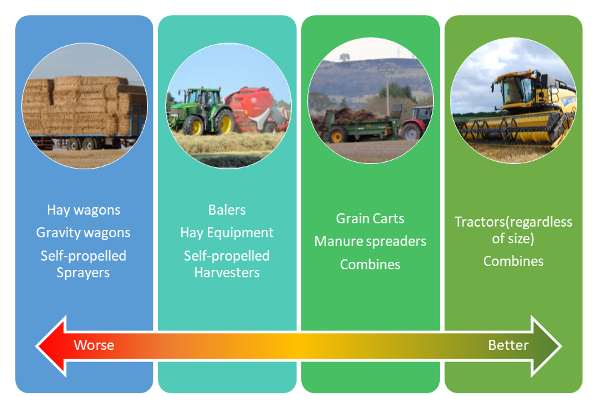Manure, compaction and cover crops
A summary of soil compaction and how to prevent it in your fields.

What is soil compaction and why does it matter?
Soil compaction is when pressure decreases the spaces between soil particles. When soils lose pore space, they have a reduced ability to hold water and air which is essential for plant growth. In many cases, when there is a compaction issue at a certain depth or on the sidewall from planting the plant root’s ability to grow is affected. Limited pore space also reduces water's ability to infiltrate the soil and properly drain, which can lead to ponding issues or additional runoff. Another complication of compaction in an increase plant injury from soil applied herbicides. Compaction can cause yield reductions under stressful growing conditions for years. It is a living environment, so it does not perform as well as it can under stress.
Most soil is susceptible to compaction. Compaction can be caused or exasperated by many factors including equipment traffic, equipment size, tillage practices and field conditions such as moisture. The type of soil in the field also plays an effect on how susceptible the field is to compaction. Sandier soils are less susceptible to compaction but can become compacted, while heavier soils are much more likely to become compacted due to their smaller particle size. Compaction can happen at distinct levels, surface crust, surface, tillage pan, subsoil.
How do I prevent compaction in my fields?
Manure itself can help alleviate compaction issues in the long term as it helps build soil organic matter and soil structure. However, the application process can be the cause of compaction when not managed correctly. Manure is often applied in the fall and spring (except for into hay fields, following wheat) when fields are sometimes wetter than other seasons in Michigan. Avoiding trafficking fields when they are saturated is the best way to prevent compaction.
Some best management practices to reduce the incidence of compaction in fields, according to Linda Schott at the University of Idaho, include making mindful equipment choices, using reduced tire pressures, and using traffic control.
Research done by the Ontario Ministry of Agriculture compared the pressure of various kinds of implements on the soil. You can see in the chart that implements with smaller tire areas can be troublesome.

Bigger tires are great, but if the contact area has not increased compaction is still a risk. Tire volume needs to be managed to get more contact area to reduce compaction. One way to do that is with a central inflation system and knowing the recommend pressure for your tires for the road and for the field.
Traffic control limits agricultural machinery traffic to designated areas, rather than across a whole field year after year. This restricts compaction to zones, while the seedbed remains undisturbed. According to the Natural Resources Conservation Service (NRCS) to accomplish controlled traffic the following must be accomplished:
- Ensure that controlled traffic lanes are designed and used to avoid concentrated flow that may result in gully erosion.
- Limit wheel/track traffic to no more than 30% of the soil surface.
- The same tracks must be used for all high load traffic continually.
- Use a Geographic Positioning System (GPS) to guide field operations and wheeled/track traffic when the designated traffic lanes are obscured.
- Once the tram lines or traffic pattern is established, do not till deeper than 4 inches.
What can I do if my field has soil compaction?
Soil compaction can mean a variety of things and happen in many ways and places in the soil. Each can be managed in the short-run through tillage at a different depth, but you cannot till your way out of a soil quality problem. There are certain things that can be done to help the overall soil structure and that are not a short-term solution. These include utilizing cover crops, building organic matter, changing management practices to avoid working the field when wet, controlled traffic, and thoughtful equipment choices.
Soils are resilient and can repair themselves if left to their own devices; however, this typically means a fallow period. We can help them repair themselves by changing our management practices to help them develop in a way that is more favorable to rebuilding that soil structure.
When choosing cover crops to help remediate, it is important to choose the right type of rooting system. In extreme cases of compaction, such as after construction activities, a pass of deep tillage may be needed before planting a cover crop. A deep-rooted cover crop such as oil seed radish and cereal rye helps to break up compaction deeper into the soil profile. While cover crops with a more fibrous root system such as oats and buckwheat will help break up crusting toward the top of the soil profile. Either way, getting living roots in the soil helps to create organic matter and pore space when they are terminated and decompose.
If you would like to learn more about compaction remediation and prevention, consider some of these resources provided by the Soil Heath Nexus. Also, MSU Extension Soil Health and Cover Crops Team has several resources on their website and they are available for consultation at your farm.



 Print
Print Email
Email



